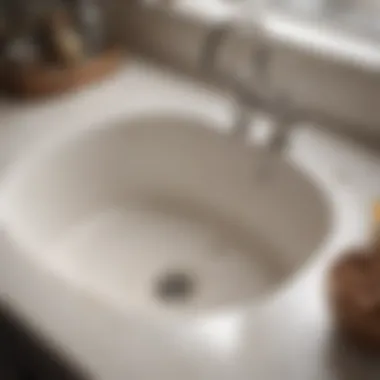Unclog Your Kitchen Sink with Baking Soda


Intro
Unclogging a kitchen sink is a common household challenge. Using baking soda offers a simple yet effective solution. This method not only unclogs the sink but also aligns with eco-friendly practices, making it suitable for all homeowners looking to maintain their space sustainably.
Understanding the science behind the reaction of baking soda with other household ingredients is crucial. Baking soda, or sodium bicarbonate, reacts with acids and bases in ways that can effectively break down clogs. This ensures a simpler approach to home maintenance without the need for harsh chemicals.
By following a structured guide, one can successfully resolve the issue of a clogged kitchen sink. The practical steps involved will be discussed in detail, including tips to prevent future clogs. This knowledge not only aids immediate concerns but also contributes to longer-term home care strategies.
Preamble to Kitchen Sink Clogs
Clogged kitchen sinks present a common household dilemma that can disrupt daily routines. Understanding the nature and effects of kitchen sink clogs is essential for efficient home maintenance. Kitchen sinks can experience clogging due to various reasons, such as food particles, grease buildup, and debris. This article explores effective methods, specifically the use of baking soda, to tackle these issues.
Understanding Kitchen Sink Clogs
Kitchen sink clogs arise when waste materials accumulate, obstructing the flow of water. The most frequent culprits are food scraps that don’t disintegrate easily, along with oily residues that harden over time. Such factors create blockages that impede water drainage, leading to frustrating situations. By recognizing the causes behind kitchen sink clogs, homeowners can take preventative actions early. For instance, using drain filters can significantly minimize the amount of debris that enters the plumbing system.
Impacts of Clogged Sinks
The effects of clogged kitchen sinks extend beyond mere inconvenience. When water fails to drain properly, it can create a breeding ground for bacteria and unpleasant odors. In severe cases, clogged sinks can lead to potential water damage or plumbing issues that require costly repairs. Moreover, the accumulation of stagnant water can foster mold growth, which is another health risk. It is prudent to address clogs swiftly and effectively to minimize these impacts. Regular maintenance and understanding the behavior of your plumbing system can highlight urgent issues before they escalate.
Baking Soda as a Cleaning Agent
Baking soda is more than just a simple ingredient in baking; it holds a valuable role as a cleaning agent in various household applications. When it comes to unclogging a kitchen sink, this common substance provides a versatile and effective solution. Its ability to interact with other compounds makes it particularly useful in tackling stubborn clogs while minimizing environmental impact. This section examines the chemical properties of baking soda and its environmental benefits, contributing to a broader understanding of its role in home maintenance.
Chemical Properties of Baking Soda
Baking soda, also known as sodium bicarbonate, is a mild alkaline compound. This means it has a pH level above 7, allowing it to react positively with acids. When utilized in unclogging, its effervescent nature comes to play. When mixed with vinegar, another common household item, they create a fizzing reaction. This reaction helps to break down debris and grease in drains effectively.
When the baking soda comes into contact with water, it immediately dissolves and begins to work. This dissolution forms sodium and bicarbonate ions, which assist in dislodging any buildup within pipes.
- Alkalinity: This property helps neutralize odors in drains and disintegrates organic matter, reducing buildup.
- Safety: Unlike many harsh chemicals, baking soda is gentle on pipes, making it suitable for regular use without fear of damage.
Environmental Benefits
Using baking soda as a cleaning agent promotes environmentally friendly practices at home. Unlike commercial drain cleaners, which may contain toxic substances, baking soda is non-toxic and safe for both humans and pets. This is particularly important for households with children or animals, where safety is a priority.
The biodegradability of baking soda means it does not contribute to water pollution. By using natural ingredients like baking soda for cleaning, homeowners reduce harmful chemicals entering the water supply. This aligns with a broader movement toward sustainable living practices.
"Baking soda represents a simple yet effective choice for maintaining clean and unclogged drains in an eco-friendly manner."


The Science Behind Unclogging
Understanding the science behind unclogging is essential for effectively utilizing natural remedies like baking soda. Many people are unaware that clogs often occur due to a combination of substances. Food particles, grease, soap residue, and hair can all contribute to this problem. When addressing these issues, knowing how baking soda interacts with these elements can be beneficial.
Baking soda serves as a powerful cleaning agent due to its ability to react with various substances. This article explores how this simple ingredient can create a dynamic reaction that aids in breaking down clogs. The knowledge of these chemical reactions not only allows for efficient unclogging but also points to environmentally-friendly practices in household cleaning.
How Baking Soda Works
Baking soda, or sodium bicarbonate, operates effectively as a cleaning agent. When introduced to water, it dissolves and yields a mild alkaline solution. This solution has the ability to dissolve grease and grime, which are common culprits in kitchen sink clogs.
When mixed with vinegar, the baking soda reacts to produce carbon dioxide gas. This fizzing action is quite effective in dislodging blockages. The gas bubbles help to agitate the clog material, assisting in its breakdown and clearance.
To utilize baking soda for unclogging, the ideal approach is a systematic application, ensuring that it penetrates deeply into the clogged area. The dual approach of using both baking soda and vinegar plays a vital role in optimizing the unclogging process.
Acidity and Alkalinity Interactions
The interaction between acidity and alkalinity is key to understanding how to unclog drains effectively. Baking soda is alkaline, while common household vinegar is acidic. When combined, they create a chemical reaction that generates bubbles.
This reaction is not just entertaining; it serves a functional purpose. The bubbles created exert pressure on the clog, helping to loosen and lift it from the pipe walls. Moreover, this reaction helps to neutralize odors that often accompany clogged sinks.
In practical application, when pouring vinegar after baking soda, the sequence enhances the unclogging effect. The initial alkalinity of baking soda followed by the acidity of vinegar results in a powerful mixture that targets various materials causing clogs.
By understanding these interactions and leveraging them effectively, homeowners can maintain clean drains with minimal effort and harm to the environment. Broad knowledge of these principles enriches the problem-solving capabilities for clogged sinks.
Detailed Steps to Unclog a Kitchen Sink
While dealing with a clogged kitchen sink can be frustrating, understanding the effective methods to resolve this issue is crucial for any homeowner. This section provides a systematic approach to unclogging the sink using baking soda, which is a safe and efficient approach. Properly executing each step not only alleviates clogs but also minimizes damage to the plumbing system. By taking a methodical stance, readers can ensure that the problem does not escalate, leading to costly repairs.
Gather Required Materials
Necessary Supplies
To effectively unclog a kitchen sink, certain materials are essential. The primary supplies needed include baking soda, vinegar, hot water, and possibly a sink plunger. These items are easy to find in most households. Baking soda is an important part of this process; its mild abrasive quality and ability to react with vinegar make it ideal for breaking down food particles and grime that may cause clogs.
A key characteristic of baking soda is its non-toxic nature. It is a common household item that many people already have on hand, making it a beneficial choice for unclogging sinks. Its unique feature lies in its ability to create a fizzing reaction when combined with vinegar, which helps to lift and break down stubborn blockages. However, it's important to note that while effective, baking soda may take time to achieve desired results.
Safety Precautions
Ensuring safety during any home maintenance task is essential. In this context, it is vital to take specific safety precautions. Firstly, using gloves while handling baking soda and vinegar can protect the skin from irritation. Secondly, ensuring the workspace is clear of other cleaning supplies prevents unintended chemical reactions, ensuring a safe unclogging process.


The key characteristic of safety precautions is their role in minimizing accidents. They provide a sense of security when working with household materials. A unique feature of these precautions is the empowerment they give individuals to take control of their own home maintenance safely. However, overconfidence can lead to neglecting such precautions, which is a risk in home maintenance activities.
Initial Drain Cleaning
Before applying baking soda, a simple initial cleaning could help remove debris from the surface of the drain. Pouring a kettle of hot water down the drain allows any loose materials to break up and flow away. This simple action primes the drain for the upcoming application of baking soda and vinegar, making it more effective. If there are items that are clearly visible in the drain, such as food remnants, it might be beneficial to remove them by hand.
Applying Baking Soda
Once the drain has been cleared to some extent, the next step involves applying baking soda. Pour approximately one cup of baking soda directly into the drain. It is important that the baking soda reaches as far into the pipe as possible without any obstruction. This allows the working agent to take full effect, ensuring that it interacts directly with the blockage.
Follow-Up with Vinegar
After the baking soda application, follow up with one cup of vinegar. The mixture of baking soda and vinegar elicits a fizzing reaction that is crucial for breaking down stubborn clogs. This effervescent action helps to dislodge food particles and any greasy substances that may be contributing to the blockage. Let this mixture sit for about 10 to 15 minutes, allowing it enough time to work through the clog.
Final Rinse with Hot Water
The last step in the unclogging process is to pour hot water down the drain. This step rinses away any residue left from the baking soda and vinegar interaction, clearing the pipes further. A steady stream of hot water, preferably boiled in a kettle, will also help flush out any remaining loosened debris. This completes a comprehensive unclogging process using baking soda effectively.
By following these steps carefully, homeowners can resolve clogs effectively while maintaining the health of their plumbing systems. It is a simple and cost-effective method that employs readily available materials.
Preventative Measures Against Clogging
Preventing clogs in your kitchen sink is often more effective than dealing with them after they occur. This section emphasizes the importance of incorporating preventative measures, offering practical strategies and insights that can keep your kitchen drains flowing smoothly.
Regular upkeep not only saves you time and money but also guides you toward becoming more sustainable in your home maintenance practices. Clogs can lead to unnecessary stress, as well as potential damage to plumbing systems. Understanding the aspects of prevention is vital, especially for homeowners who wish to maintain their kitchen environments efficiently.
Regular Maintenance Tips
Establishing a routine maintenance schedule is crucial in avoiding clogs. Here are several effective strategies you can adopt:
- Routine Drain Cleaning: Use a mixture of baking soda and vinegar on a monthly basis. This natural mixture can help keep the pipes clean by breaking down buildup.
- Hot Water Flushes: Running hot water through your sink daily can help dissolve grease and fats that might otherwise accumulate.
- Strainer Use: Consider installing strainers or screens over drain openings to catch food particles and debris before they enter your plumbing.
Implementing these measures ensures your kitchen sink remains functional and clog-free without extensive intervention tasks.
Common Practices to Avoid Clogs
Being mindful of what goes down the drain can significantly mitigate clogging issues. Below are common practices to implement:
- Avoid Grease Disposal: Never pour fats, oils, or grease down the sink, as these can solidify and create a blockage. Instead, dispose of them in the trash or compost.
- Food Waste Awareness: Limit the disposal of fibrous foods, such as celery and potato peels, in the sink. These materials can wrap around or bottle up in pipes, leading to clogs.
- Educate Household Members: Ensure everyone in your home understands these rules. Proper communication can keep sink usage consistent and aware.


By following these practices, you minimize the risk of clogs developing in your kitchen sink, leading to a healthier and more efficient household environment.
"An ounce of prevention is worth a pound of cure."
In summary, investing time in preventative measures against clogs can save you from the hassle of dealing with plumbing issues later on. Regular maintenance coupled with mindful practices can create a sustainable home care routine that benefits not only individual households but the environment as well.
Alternative Solutions and Techniques
When dealing with kitchen sink clogs, exploring alternative solutions and techniques is essential. While baking soda is widely recognized for its efficacy, there are other methods available. Understanding different options can empower homeowners to resolve issues effectively. Not all clogs respond to the same approach, so familiarity with these alternatives can lead to better outcomes.
Other Natural Remedies
Apart from baking soda, various natural remedies can be employed for unclogging sinks. These include:
- Salt and Vinegar: Combining salt with vinegar creates a reaction that can help dissolve debris in pipes. The mixture must sit for a while to penetrate the clog effectively.
- Boiling Water: Pouring boiling water down the drain can often help dissolve minor blockages. It is a simple and straightforward method that requires no other materials.
- Dish Soap and Hot Water: This method involves pouring a generous amount of dish soap followed by hot water into the drain. The soap acts as a lubricant, enabling grease and grime to slip away more easily.
- Coffee Grounds: Some people find success using used coffee grounds in small amounts, they can help remove buildup in the pipes.
While these remedies can be effective, their success largely depends on the specific type of clog. Using natural methods can also reduce harmful chemicals in the home environment.
When to Call a Professional
In certain situations, attempting to unclog a kitchen sink with home remedies may not yield results. Recognizing when to call a professional plumber is crucial in these cases. Here are signs that it might be time to reach out for expert help:
- Persistent Clogs: If clogs recur frequently despite attempts to clear them, it may indicate a more serious underlying issue.
- Multiple Drain Issues: If several sinks or drains are affected simultaneously, this could signal a larger plumbing problem that requires professional assessment.
- Unpleasant Odors: Foul smells emanating from drains can be a sign of decay within the plumbing system, indicating that professional services are needed.
- Home Renovations: If you are undertaking home renovations that involve plumbing changes, consulting a professional ensures everything functions properly during and after the project.
By understanding these signs and knowing when to enlist expert support, homeowners can better manage their plumbing issues and maintain their home effectively.
Calling a professional early can save time and prevent further damage to plumbing systems.
Epilogue
In summarizing the strategies outlined in this article, it is essential to digest the impact of utilizing baking soda for unclogging kitchen sinks. Baking soda offers an effective method, primarily due to its chemical properties that react with common substances found in household cleaning. This reaction not only aids in achieving a clear drain but also aligns with a growing need for sustainable practices in home maintenance.
Recap of Key Points
The crucial points to remember include:
- Chemical Reaction: Baking soda interacts with vinegar to create carbon dioxide, which helps dislodge clogs.
- Eco-Friendly Solution: Unlike harsh chemicals, baking soda is gentle on the environment.
- Step-by-Step Process: Utilizing a systematic approach can ensure effective unclogging with minimal hassle.
- Preventative Measures: Regular maintenance and mindful practices can significantly reduce the occurrence of clogs.
By reinforcing these points, homeowners can grasp the practicality of adopting baking soda as a cleaning agent.
The Importance of Sustainable Practices
Adopting sustainable practices in everyday cleaning not only benefits the environment but also enhances one's quality of life. Using natural substances like baking soda minimizes exposure to toxic ingredients typically found in commercial cleaners. This shift towards environmentally friendly solutions is crucial in a time when household waste and pollution are significant concerns.
Encouraging the use of baking soda aligns with a broader societal trend of seeking healthier living environments. Homeowners, thus, play a dual role in maintaining their properties while contributing to global sustainability efforts. As the journey towards cleaner homes continues, baking soda will remain a valuable ally in both unclogging sinks and promoting eco-conscious habits.















